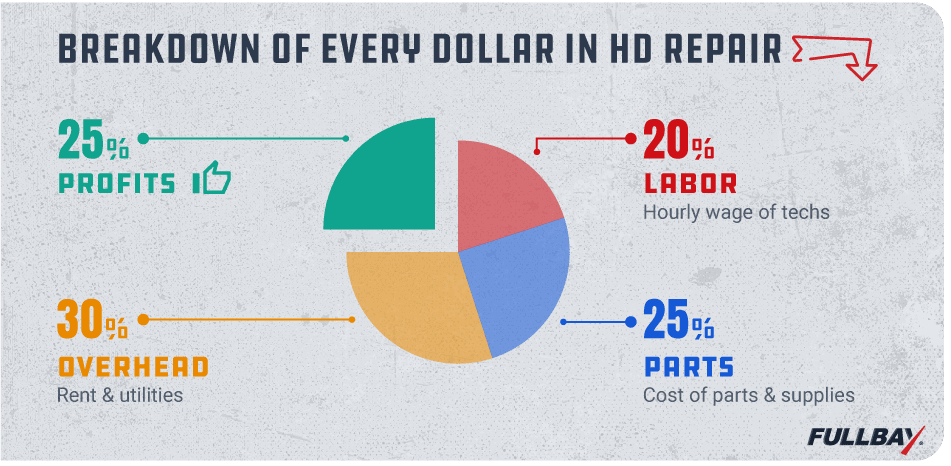Dude, Where’s My Profit? 7 Ways to Recover Revenue

If you follow our blog, you know we talk a lot about the business side of things—you know, the hiring efforts, the reports, the revenue. After all, once you become an owner, it’s not just about turning wrenches anymore.

We recently updated an article about shop profitability, revisiting the benchmarks it provided to make sure they were still in line with how the industry is operating.
While we worked on it, we started wondering: What happens if a shop isn’t hitting anywhere near those benchmarks, or their revenue is otherwise, well, all over the place? How can they right the ship?
We pulled in a couple of experts from Fullbay to help us out: COO Chris O’Brien and Director of Finance Robert Gilbert.
Now, let’s start getting that revenue under control. The first step, according to the guys, is finding out why your revenue has gone wacky.
Review your revenue
If your revenue isn’t where it should be, it is usually for one of the following reasons:
- You had your revenue set up correctly (via a solid financial plan), but you kept that same plan for months or years when you should have made changes.
- You never had a plan in the first place.
We are big on financial plans and setting goals (or KPIs, if you want). They’re absolutely key to tracking your progress and figuring out what you’re doing, where you’re going, and what adjustments to make to get there.
We really can’t hammer that home enough. “If those benchmarks look pretty far away,” Chris says, “look at your plan. That’s your building block to running a shop.”
If you don’t have a plan, and you aren’t sure what your benchmarks are, then it’s time to get started. Compile the following information:
- What are you currently paying your techs?
- What is your labor rate?
- What is your parts markup?
- Have you made any adjustments from this year to last year? (You can go back multiple years if you enjoy torturing yourself.)
- Have you made any adjustments from the last six months to the current six months?
Once you have your plan or at least your current numbers in front of you, look into how many adjustments you’ve made over the last few months or years. Chris believes it’s the stagnation that really kills the revenue; that’s a sign that you aren’t changing with the times (and these days, the times change fast). Remember, your plan isn’t a thing that is etched in stone and left untouched until land sharks take over the world. The market changes. Inflation is here.
“You have no choice but to respond to things,” Chris says. “Not responding to them is why your numbers aren’t matching.”
Bringing balance to the Force
Okay. We know why revenue falls apart. How do we fix it?
(Besides winning the lottery.)
“Set a plan,” Robert advises, “and work towards that plan.”
If you already had a plan and needed to update it, now’s your chance. If you didn’t have a plan, well, now is still your chance! For this article, we’ll assume you are going to work toward Fullbay’s benchmarks (provided above).
1. Make sure your parts department and service writers are holding margins
Is your parts manager incentivized to hold a specific margin? They should be. An appropriate margin on parts helps ensure you’re making what you should off the parts you sell; it can help make up for the fluctuations in labor rates, overhead, and other costs of doing business.
Fullbay can help you out here, by the way. Start looking at your velocity and other parts reports at least weekly. If they’re way out of line, start looking at them daily. “You can’t just set plans and assume they’re going to happen,” Chris says. “You actually have to monitor them incrementally.”
On that note, your service writers should also be held to margin as they write tickets. Set goals for your teams, or build out bonuses or other structures to really incentivize your crew.
2. Review your contracts—right now!
It happens to all of us: we sign an amazing contract that we’re very happy with for several months or years. But changes in the market, in your shop, and even in the world abruptly mean the contract no longer serves you like it did.
(Or, if you’re new to the biz, maybe you set up a contract that wasn’t super great from the get-go and you’re juuuuust realizing that now. Again, it happens to a lot of us.)
Are you in any contracts that can be renegotiated? Do you have contracts that have stipulations for things like COVID or natural disasters? Government contracts in particular tend to have a clause that allows you to adjust or modify things in certain scenarios.
“A lot of those contracts with specific pricing built into them have Consumer Price Increase (CPI) adjustments,” Robert points out. Look for language in the contract that says “If the CPI goes above this, then you can charge this. But you’ve got to keep an eye on those.
“The person buying from you won’t tell you when [the CPI] goes up. Only when it goes down.”
Some contracts—especially with big-ticket customers—also include “Most Favorable Customer” clause. Basically, this clause translates to “I get the best pricing no matter what.” That means if you offer a better price to another customer, the customer featured in this contract automatically moves down to that next pricing level. It’s hard to prove, but if they do find out you’re charging someone else less, you can get into a lot of trouble.
In short, look at your contracts and make sure you’re not putting things into place that seem like a great deal today but will harm you later.
3. Update your shop supply fees and mileage charges…seriously!
Even if you’re locked in a contract that doesn’t allow a ton of changes, most (again, not all) will let you make adjustments to shop supplies and (for a mobile truck) mileage charges. So hike those fees a bit.
You might be surprised by how many expenses hide out in your shop supplies, so make sure you’re evaluating them regularly. The rags in your shop that you need to pay to be laundered. The tech uniforms that you need to pay to be laundered (and in some cases repaired). The sandblaster in the corner. The parts cleaner that has the fluid that costs $700 to switch out every quarter.
4. Return your cores!
Chris hasn’t yet run into a shop that hasn’t lost money on cores. If your revenue is giving you hives and you haven’t done anything with your cores, get moving. You could have $2-$10K just scattered around the shop because you haven’t gotten around to returning them yet. This is cash! Return it to the vendor! Maintain your margin! You can tell we’re serious because we’re using so many exclamation points!
5. Look at your overhead
Full disclosure: this isn’t always an area you can cut a lot out of. It requires looking at things and deciding what you need and what you don’t need.
A lot of your overhead costs like lease/mortgage payments and utilities are largely fixed. And areas where you can potentially make cuts—say, in stuff you provide for your techs—should probably be left alone because you want to keep the talent happy.
(Also, downgrading your coffee never, ever works out well in the end. Trust me, I’m a writer.)
You might also look at your marketing budget, which can get wildly out of hand if you’re just doing things yourself. We don’t suggest cutting it entirely, because marketing is what scores you new (and ultimately better!) business. But if you’ve been pouring money into marketing and not seeing the return you want, it’s time to rethink how you handle it.
(Hey! Here is a shameless plug for Dieselmatic, a diesel-centric marketing agency that will spread the word about your shop.)
6. Review your relationships
Are your relationships with customers damaging your revenue streams? Maybe.
Before anything else, let’s clarify: YES, this is a relationship-driven business! And the working relationships you forge with your customers are incredibly important. But many shop owners fall into the trap of starting out their first customers with extremely low rates…and then never raising them.
Ever.
We could tack this under the “review your contracts” section, but honestly, this stands on its own because sometimes customers become friends. Sometimes owners just feel obligated to maintain a rate for years. Sometimes it’s a mix—who knows? Whatever the reason, you’re still missing out on revenue that’s probably hurting you. Because unless you’re absolutely rolling in dough, you probably aren’t giving your friends thousands of dollars a year, right? Right. But that’s what you’re doing when you’re not charging appropriately for shop supplies, labor, and parts.
Your customers are just about getting away with murder, but they don’t realize it. And it’s not their fault. That’s on you. If you’re practically giving away work to the fleet that’s been with you for 20 years…that’s not going to keep the lights on.
7. Expand your parts matrix
If your numbers still aren’t working and you’ve tried everything else, it’s time to re-evaluate your parts matrix. “If your matrix is only five levels, or ten levels, maybe it needs to be 20 levels,” Chris says.
Yes, that feels pretty complex, especially if you’re panicking over where your revenue is going. But keep calm and matrix on. You have to look at your sales, where they’re coming from, and basically capture a little more markup on each of those segments. This basically spreads the increase around—you’re improving your margin, but your customers are only paying a few extra bucks here and there.
Sometimes a little more margin is all you need.
In addition to all of the above, you should also be reviewing your labor rate (on top of the hourly rate you pay your techs) to make sure it’s in line with your regional market. But you knew that, right?
Never Stop Evaluating
Chris leaves us with one last piece of wisdom: Evaluate.
Any kind of process improvement requires being studied again and again as times and business change. Evaluate your goals—and especially your parts markup—at least semiannually. “If you can’t do that, I can already predict you’re gonna have problems,” he says. “Just when you think it’s perfect, guess what? It’s time to go look at it again.”
We’d be remiss if we didn’t mention Fullbay makes it easy to do that—and just about everything else we talked about in this article. From outstanding reporting capabilities to inventory management and even parts purchasing power, we pull back the curtain from your shop’s inner workings, showing you exactly what’s going on and what you’re pulling in.
Running a shop is hard work no matter how you slice it, but if you use Fullbay the way it’s intended, you can see what’s going on and make adjustments as necessary. It’s a game-changer—and hopefully a revenue-increaser—for everyone!

